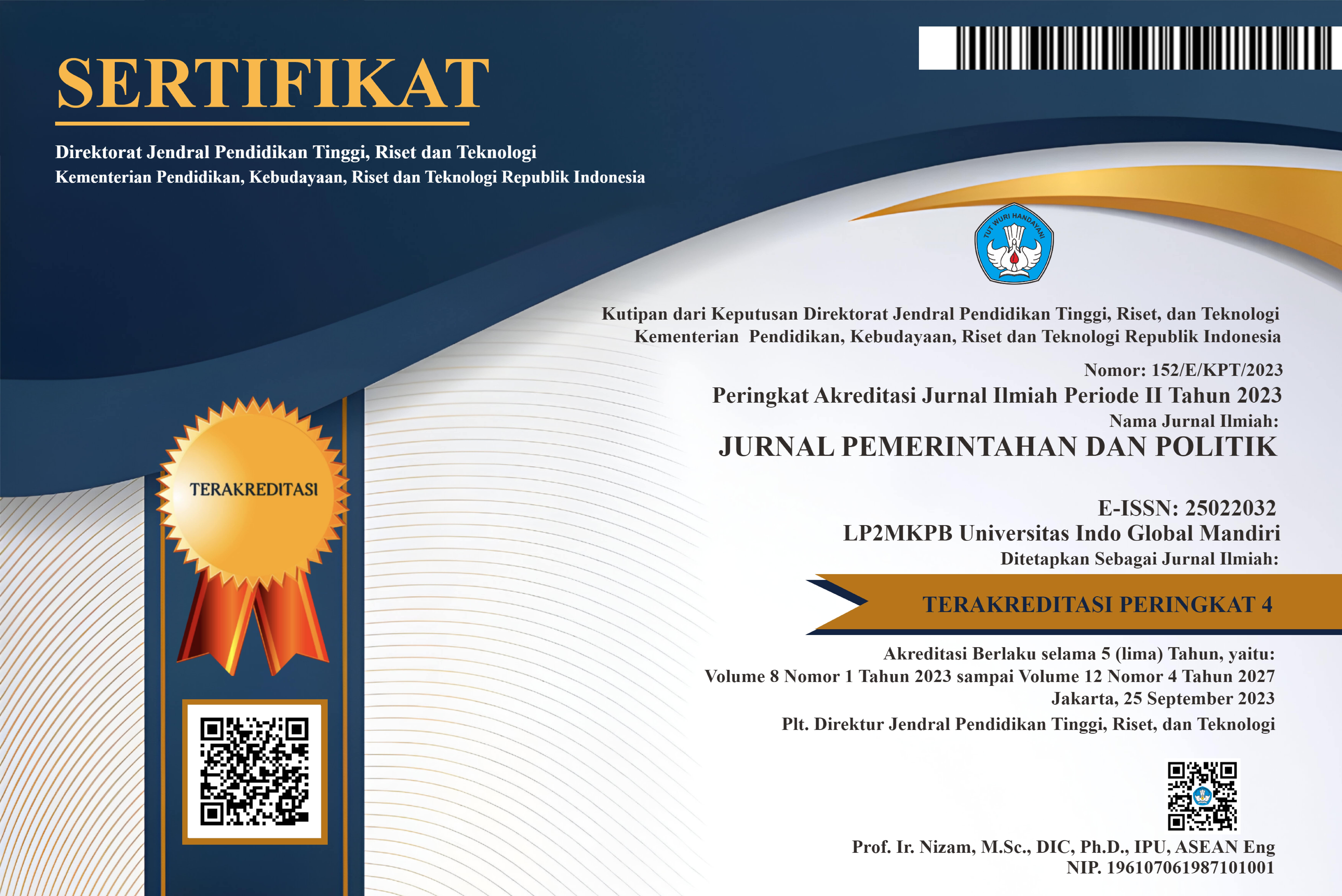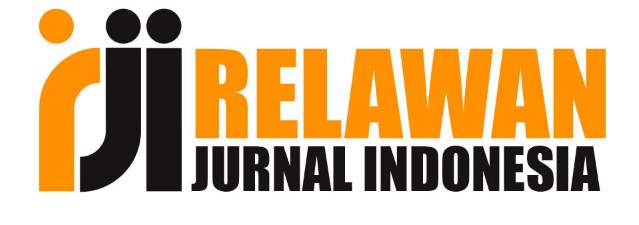Bibliometrik Pengukuran dan Manajemen Kinerja di Indonesia
DOI:
https://doi.org/10.36982/jpg.v8i1.2902Abstract
Penelitian ini bertujuan untuk menganalisis kepustakaan pengukuran dan manajemen kinerja dalam database Scopus yang ditulis oleh peneliti Indonesia. Proses pencarian dengan kategori“title, abstract and keyword: “performance measurement†and “performance management†ditemukan sebanyak 1.253 artikel, penulis hanya mengambil artikel yang terbit di Negara Indonesia dan dalam bahasa Inggris serta mengurutkannya berdasarkan relevansinya yaitu sebannyak 22 artikel. Kemudian melakukan analisis bibliometric dengan menggunakan perangkat lunak VOS viewer versi 1.6.18, selanjutnya data base tersebut akan di analisis berdasarkan tren publikasi pertahun, affiliasi paling produktif, penulis paling berkontribusi, dan bidang ilmu terkait. Hasil analisis menunjukkan bahwa artikel pertama diterbitkan pada tahun 2008 tentang sistem pengukuran kinerja berbasis pengetahuan hybrid, artikel berikutnya kemudian baru muncul 3 tahun setelahnya, Wibisono merupakan penulis paling berkontribusi, Institut Teknologi Bandung adalah affiliasi paling produktif dan pengukuran dan manajemen kinerja paling banyak terbit pada bidang ilmu bisnis, management dan accounting. Artinya penelitian tentang pengukuran kinerja masih belum banyak dibahas oleh peneliti Indonesia khususnya ilmu sosial karena berdasarkan data yang ditemukan bidang ilmu sosial hanya berkontribusi 7,5% dari artikel yang terbit di Indonesia.
References
Akbar, R., Pilcher, R. A., & Perrin, B. (2015). Implementing performance measurement systems: Indonesian local government under pressure. Qualitative Research in Accounting and Management, 12(1), 3–33. https://doi.org/10.1108/QRAM-03-2013-0013
Akbar, R., Pilcher, R., & Perrin, B. (2012). Performance measurement in Indonesia: the case of local government. Pacific Accounting Review, 24(3), 262–291. https://doi.org/10.1108/01140581211283878
Al-Suwaidi, K., & Al-Syouf, I. (2020). Productivity in public sector services: Results of a systematic literature review. Proceedings of the International Conference on Industrial Engineering and Operations Management, 0(March), 2229–2237.
Arnaboldi, M., Lapsley, I., & Steccolini, I. (2015). Performance Management in the Public Sector: The Ultimate Challenge. Financial Accountability and Management, 31(1), 1–22. https://doi.org/10.1111/faam.12049
Donthu, N., Kumar, S., Mukherjee, D., Pandey, N., & Lim, W. M. (2021). How to conduct a bibliometric analysis: An overview and guidelines. Journal of Business Research, 133(March), 285–296. https://doi.org/10.1016/j.jbusres.2021.04.070
Eliyana, A., Ma’arif, S., & Muzakki. (2019). Job satisfaction and organizational commitment effect in the transformational leadership towards employee performance. European Research on Management and Business Economics, 25(3), 144–150. https://doi.org/10.1016/j.iedeen.2019.05.001
Garicano, L., & Heaton, P. (2010). Information technology, organization, and productivity in the public sector: Evidence from police departments. Journal of Labor Economics, 28(1), 167–201. https://doi.org/10.1086/649844
Halkos, G., & Bousinakis, D. (2010). The effect of stress and satisfaction on productivity. International Journal of Productivity and Performance Management, 59(5), 415–431. https://doi.org/10.1108/17410401011052869
Heinrich, C. J., & Marschke, G. (2010). Incentives and their dynamics in public sector performance management systems. Journal of Policy Analysis and Management, 29(1), 183–208. https://doi.org/10.1002/pam.20484
Hvidman, U., & Andersen, S. C. (2014). Impact of performance management in public and private organizations. Journal of Public Administration Research and Theory, 24(1), 35–58. https://doi.org/10.1093/jopart/mut019
Khurshid Khan, M., & Wibisono, D. (2008). A hybrid knowledgeâ€based performance measurement system. Business Process Management Journal, 14(2), 129–146. https://doi.org/10.1108/14637150810864899
Klijn, E. H. (2012). New Public Management and Governance: A Comparison. In The Oxford Handbook of Governance (Issue October, pp. 201–214). Oxford University Press. https://doi.org/10.1093/oxfordhb/9780199560530.013.0014
Makarius, E. E., Mukherjee, D., Fox, J. D., & Fox, A. K. (2020). Rising with the machines: A sociotechnical framework for bringing artificial intelligence into the organization. Journal of Business Research, 120(November 2019), 262–273. https://doi.org/10.1016/j.jbusres.2020.07.045
Musso, J. A., & Weare, C. (2020). Performance Management Goldilocks Style: A Transaction Cost Analysis of Incentive Intensity in Performance Regimes. Public Performance and Management Review, 43(1), 1–27. https://doi.org/10.1080/15309576.2019.1677481
Neely, A., Gregory, M., & Platts, K. (1995). Performance measurement system design: a literaturer review and research agenda. International Journal of Operations & Production Management, 15(4), 80–116.
Newcomer, K. E., Hatry, H. P., & Wholey, J. S. (2015). Handbook of Practical Program Evaluation ( and J. S. W. Kathryn E. Newcomer and Harry P. Hatry (ed.); 4th ed.). John Wiley & Sons, Inc. http://dx.doi.org/10.1016/j.cirp.2016.06.001%0
Ömürgönülşen, U. (2002). Performance Measurement in the Public Sector: Rising Concern, Problems in Practice and Prospects. Cilt, 20, 99–134.
Simon, H. A., Smithburg, D. W., & Thompson, V. A. (2003). Handbook of Public administration (B. G. Peters & J. Pierre (eds.); 1st ed.). Sage Publications. https://doi.org/10.4324/9781315127705
Vignieri, V. (2018). Performance Management in the Public Sector. Global Encyclopedia of Public Administration, Public Policy, and Governance, 1–8. https://doi.org/10.1007/978-3-319-31816-5_3480-1
Wholey, J. S., Hatry, H. P., & Newcomer, K. E. (2010). Handbook of Practical Program Evaluation (J. S. Wholey, H. P. Hatry, & K. E. Newcomer (eds.); 3rd ed.). John Wiley & Sons, Inc. https://doi.org/10.1177/0899764011420366









